 By Jim Feilders By Jim Feilders
February 25th, 2019
BURLINGTON, ON
Building height and tree removal are like car speed.
There is no maximum.
After a certain point you pay for it in the form of a fine.
The higher the building, the more you pay the government.
The more trees removed, the more you pay the government.
The more you speed, the more you pay the government.
The Planning Act of Ontario has what is known as a Section 37 which allows a developer to offer a benefit to a municipality for additional height. There is no specific rate for the size of the benefit and the additional height permitted.
Section 37 Benefits
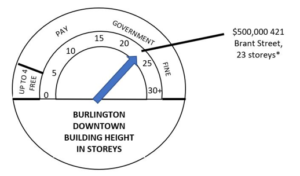 1 to 5 storeys over the limit, XXX per floor 1 to 5 storeys over the limit, XXX per floor
6 to 10 storeys over the limit, XXX per floor
11 to 20 storeys over the limit, $26,316 per floor*
21 to 30 storeys over the limit, XXX per floor
30+ storeys over the limit, XXX per floor
The Highway Traffic Act of Ontario sets out what it is going to cost when you exceed the speed limits.
 1-19 km/h over the speed limit is a $2.50/km speeding fine. 1-19 km/h over the speed limit is a $2.50/km speeding fine.
20-29 km/h over the speed limit is a $3.75/km speeding fine.
30-49 km/h over the speed limit is a $6.00/km speeding fine.
50+ km/h over the speed limit comes with a court decided fine.
Burlington Roseland Pilot Private Tree Bylaw set out what it will cost to remove trees of a specific size
 30 to 50 cm, $1400 per tree removed 30 to 50 cm, $1400 per tree removed
Over 50 cm, $2100 per tree removed
Specialty and boundary trees, see details
That is the Law
If nothing is done, exit signs on the QEW coming from Hamilton might well say:
Next Exit Burlington Downtown, Brant Street
CAUTION
Tall Buildings
Narrow Streets
No Sun
No Trees
No Oxygen
No Beach
No Parks
No Parking
No Transit (call Uber)
No Grocery Stores
No Community Gardens
PROCEED AT YOUR OWN RISK
Next Exit Burlington GO Station Mobility Hub, Guelph Line
CAUTION
No Development for 20 Years
Next Exit Oakville Downtown, Trafalgar Road
Low Rise Buildings
Wide Tree Lined Streets
Sun
Trees
Oxygen
Waterfront Park
Community Parks
Parking
Public Transit
Grocery Stores
Community Gardens
Boating, Swimming, Museums, Shopping, Libraries
Developers Proceed to GO Station Intensification Area
What can be done to create a vibrant Burlington downtown?
Community benefits increased to $500,000 per floor to pay for infrastructure, affordable housing and sustainable development.
City wide private tree bylaw requiring equivalent caliper diameter replacement on site, with no cash in lieu (same as Site Plan Application Guidelines Section 9).
Rezone employment lands for mixed use with minimum job criteria.
Rezone religious institution blocks for mixed use with minimum affordable housing criteria.
Enforce Sustainable Building and Development Guidelines by passing net zero energy/net zero carbon/net zero waste building bylaw.
 Jim Feilders is an engineer by training and an environmentalist by choice. He drives a hybrid car, heat and air conditions his house at a cost of of approximately $375 a year. The views expressed here are solely his own and not necessarily those of the various organizations with which he is associated. Jim Feilders is an engineer by training and an environmentalist by choice. He drives a hybrid car, heat and air conditions his house at a cost of of approximately $375 a year. The views expressed here are solely his own and not necessarily those of the various organizations with which he is associated.

 By Pepper Parr By Pepper Parr
February 24th, 2019
BURLINGTON, ON
The deadline for what has been an annual event for the past 53 years is February 28th. The city asks the citizens to nominate people they feel have served the city well in eight categories.
 The 2017 winners pose with their awards. From left to right: Kim Moss (Community Service), Addison Wood (Junior), Ron Danielsen, on behalf of Friends of Freeman Station (Heritage), Mae Radford (Senior), Osob Adus (Citizen of the Year), Mayor Rick Goldring, Bill Murray (Accessibility), Teresa Seaton (Arts Person), Gloria Reid (Environmental) The eight categories are:
Citizen of the Year
A person whose volunteer activity has made a significant and sustained contribution to the vibrancy and well being of the Burlington community in 2018.
Junior Citizen of the Year
A youth, 14-18 years of age who has made a significant contribution to the Burlington community in 2018.
Senior Person of the Year
A person, 55 years or older who has made a significant contribution to the Burlington Community and/or advocated on behalf of seniors in 2018.
Environmental Award
An individual or group that improved and/or protects Burlington’s environment in 2018.
Arts Person of the Year
An individual who has contributed to the arts in Burlington as an artist, patron or advocate including but not limited to, visual arts, media arts, musical arts, performing arts and literary arts in 2018.
Community Service Award
An individual or group whose volunteer activity has contributed to the betterment of the Burlington community in 2018.
Heritage Award
An individual or group who has demonstrated a commitment to the preservation of Burlington’s heritage, and has volunteered their time in an effort to support the preservation of Burlington’s heritage in 2018.
Accessibility Award
An individual, organization or business who have made significant contributions to increase access and participation of people with disabilities in the Burlington community in 2018.
In the past the city has stretched the nomination date – the uptake on the part of the citizens wasn’t as robust as it could have been.
 Many have used their being named one of the Best as a launch for a political career. There have been some abuses: wives have nominated husbands; mothers have nominated sons Many have used their being named one of the Best as a launch for a political career. There have been some abuses: wives have nominated husbands; mothers have nominated sons
This, the 53rd event is reported to be the last.
Gazette sources have advised that the program will come to an en this year.
Established in February 1965 as the Civic Recognition Committee it may have outlived its usefulness.
What isn’t clear is – who made the decision to end the program?

 By Pepper Parr By Pepper Parr
February 24th, 2019
BURLINGTON, ON
Now that they are comfortable in the new Council chambers the seven people you elected to guide the direction Burlington is to go in the next four years, we get to learn how much it cost each candidate to get elected and where the money came from.
The process, which is lengthy and drawn out, begins on Wednesday, Feb. 27, 2019 which is the last day for Clerk to provide notice of financial filing requirements and penalties to candidates and registered third parties.
 City Council on inauguration day. Thursday, March 28, 2019
Last day for candidate or registered third party to apply to Superior Court of Justice to extend the time to file the financial statement.
Friday, March 29, 2019 By 2 p.m.
Last day for all candidates and registered third parties to file their preliminary financial statements for reporting period ending Dec. 31, 2018
Last day for candidate or registered third party to notify Clerk of filing extension received from the Superior Court of Justice
After 2 p.m.
90-day compliance audit period begins
Start of 30-day period in which a candidate or registered third party can file the primary financial statement and pay a $500 late filing fee
Monday, April 29, 2019
By 2 p.m.
Last day for a candidate or registered third party to file a primary financial statement and pay the $500 late filing fee.
Last day for Clerk to review financial statements and report on any that have exceeded the limits
Thursday, June 27, 2019
Last day to request a compliance audit on a primary financial statement
Tuesday, July 2, 2019
End of supplementary campaign period
Wednesday, Aug. 28, 2019
Last day for Clerk to provide notice of supplementary filing requirements and penalties to candidates or registered third parties.
It will be interesting to see if any of the Third Party Advertisers actually file financial reports – recall that all, except for one, were numbered corporations that could care not as much as a whit if they were prevented from participating in a future election.

 By Ray Rivers By Ray Rivers
February 23RD, 2019
BURLINGTON, ON
It is bizarre that it has got this far and has gone on for this long.
Recognized as Canada’s national newspaper, though only second by circulation, the highly respected Globe and Mail has created a political scandal out of apparently thin air. The paper has relied on unsupported allegations to make its case that there has been political interference in the administration of federal legal proceedings against SNC Lavalin.
 The good days when the Prime Minister appointed Jody Wilson Raybould Minister of Justice and Attorney General of Canada It may have been only a couple of weeks since the Globe’s story hit the pavement but somebody needs to start tallying up the costs for this story, which has grown a lot of legs but no teeth. Already the former Attorney General, Jody Wilson-Raybould and the PM’s Principal Secretary, Gerald Butts, have both resigned. The Commons Justice Committee has had to start special hearings and the Ethics Commissioner has been called in. Lavalin has suffered its first financial loss in six years and its shares are plummeting.
Then there is all the ink that has been spilled over what more and more appears to be the Globe’s non-story. The PM has been consistent. He said the Globe was wrong on day one. Then he followed up emphatically stating that neither he nor his office gave the former AG or her staff direction on the file – in fact reiterating that he had instructed her that the decision to intercede on SNC was hers and hers alone.
The Clerk of the Privy Council, the most senior bureaucrat in Ottawa has identified three critical meetings, where Wilson-Raybould might have felt there had been pressure, including one with him, one between Butts and her senior assistant, and one she had had with the PM back in September, which started out as a meeting on the indigenous file.
 President knew how to apply pressure to the members of Congress. Now the Globe has modified their story from allegations of political interference to somebody pressuring the AG. Pressure? What else does one expect in political life but pressure? Going for that nomination, running an election campaign, debating other candidates, being on call by constituents once elected, standing up in the House, attacking and being attacked. I’m sorry but if you can’t stand the heat get out of the kitchen.
In the matter of SNC, Canadians should expect that our politicians would look long and hard at options to, essentially, putting a Canadian icon, Lavalin, out of business for something a handful of former executives did almost two decades ago, in a land so far away and as corrupt as Libya. Imagine the pressure the over 8,000 Canadian SNC employees will feel if their company shuts down or is sold to a foreign entity, as had happened with Alcan and Rona.
Of course Lavalin might win its court case. But is the cost of prosecuting worth it, when a modern legal disciplinary alternative to lengthy and costly trials for these kinds of white collar crimes exists?
The elected government makes the laws and the prosecutor applies them, but even in TV’s Law and Order there is ample discussion among the parties about the best way to prosecute, and when to accept plea bargains.
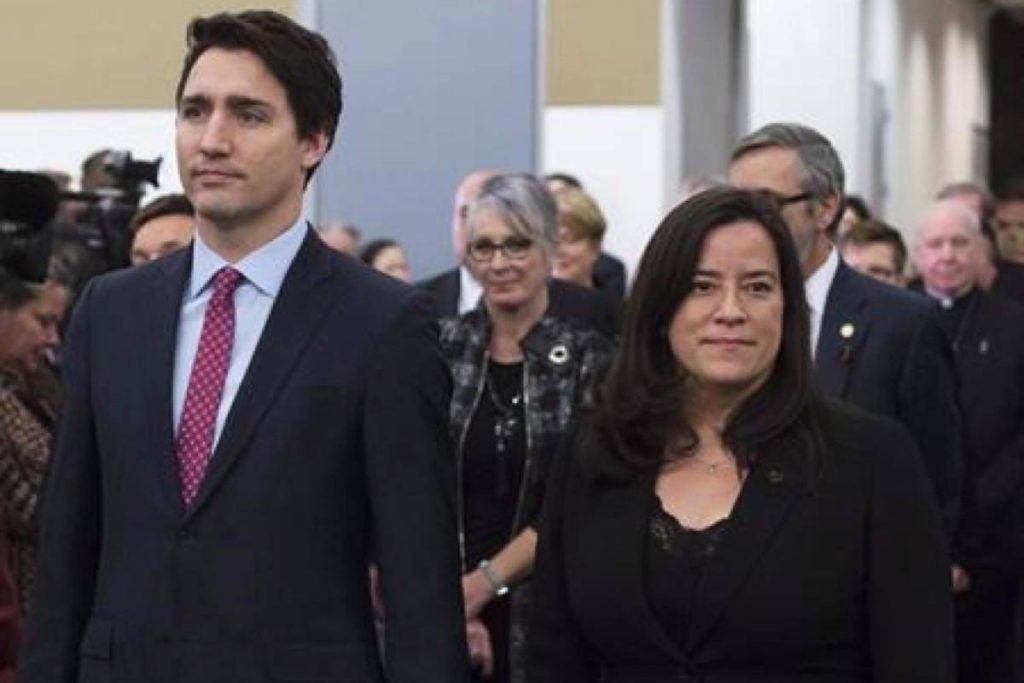 She was no longer the Minister of Justice. The former AG is set to address the Justice Committee early this coming week so we might finally all understand what she means by pressure – assuming those are her words. But even if she felt there was pressure and that others were being insensitive – it obviously wasn’t the pressure that forced her to resign. She resigned well after being shuffled out of the AG’s office.
What goes on in the PM’s Cabinet room is top secret and Cabinet solidarity is at the heart of our governance system. Breaking confidentiality has serious consequences as two federal officials are finding out for allegedly leaking details on shipbuilding contracts. So where did the Globe and Mail get their information? And if it was from the former AG, or anyone Wilson-Raybould had communicated with, wouldn’t that make a mockery of her current protestations about attorney-client privilege?
The PM has told us that he shuffled Jody Wilson-Raybould out of the AG’s office for a number of reasons. Wilson-Raybould understood that being minister of aboriginal affairs would have been an inappropriate appointment for her, given her background. But there are also a number of legal issues coming forward which affect the indigenous communities, including self-government, first nations reconciliation and the Trans Mountain pipeline. Any one of these might find her in a potential conflict of interest situation as Canada’s AG.
 Are newspapers in place to make news as well as report it? The role of newspapers is typically to report the news, not to make it. The Globe has decided on the latter in this case. Perhaps the Globe’s editors were just trying to liven up or balance out the federal political scene. Perhaps they wanted to sell more papers. Or perhaps they were hoping to influence the outcome of the next election with a story replete with unsupported innuendo.
Unless the former AG reveals something earth-shattering with her testimony at the Justice Committee, this will be a sad mark on the pages of the Globe. Trudeau has clearly been affected by all the commotion, losing his friend and chief organizer Butts in the process. Trudeau came to office embracing feminism and an obligation to lift Canada’s indigenous people beyond their current state.
In Jody Wilson-Raybould he, no doubt, saw the embodiment of that ambition. He recruited her, brought her into federal politics, and placed her in one of the most senior appointments in his cabinet. It is no wonder that he seems hurt and unhappy.
 Prime Minister Justin Trudeau takes a selfie. The PM is responsible for appointing and shuffling cabinet ministers at his discretion, and they serve at his pleasure. Trudeau has delegated more authority to his ministers than any PM since his father. That he would be accused of overriding, directing, influencing or pressuring a minister of his Cabinet, and the Attorney General in particular, must indeed be a bitter pill for him to swallow.
And with all the accusations by the G&M, opposition calls to bring in the RCMP, pundits demanding the PM resign, is there little wonder that the smile has departed from even this PM’s face. So anyone wanting a selfie might want to keep that thought until the Globe and Mail prints a retraction of the story.
 Ray Rivers writes weekly on both federal and provincial politics, applying his more than 25 years as a federal bureaucrat to his thinking. Rivers was a candidate for provincial office in Burlington where he ran against Cam Jackson in 1995, the year Mike Harris and the Common Sense Revolution swept the province. He developed the current policy process for the Ontario Liberal Party. Ray Rivers writes weekly on both federal and provincial politics, applying his more than 25 years as a federal bureaucrat to his thinking. Rivers was a candidate for provincial office in Burlington where he ran against Cam Jackson in 1995, the year Mike Harris and the Common Sense Revolution swept the province. He developed the current policy process for the Ontario Liberal Party.
Background links:
Justice Committee Analysis – PM’s Discretion –
Wilson- Raybould – More Reasons Why – SNC Legal Options –
Shawcross Rule – Wilson-Raybould Future –
Understanding Jody – Butts –
Indigenous Issues – Cabinet Secrets –

 By Roland Tanner By Roland Tanner
February 23, 2019
BURLINGTON, ON
If the new 29 storey proposal for Lakeshore and Pearl is ultimately approved at the Local Planning Appeals Tribunal (LPAT), and forced on Burlington in a form anything like this first proposal, ECoB Engaged Citizens of Burlington, believes we are seeing an Ontario-wide collapse in the ability of municipalities to govern their own planning and development.
The public meeting held for the Carriage Gate development at 2069-2079 Lakeshore Road and 383-385 Pearl Street on January 29th was one of the most heated yet held in Burlington. Over two hours, residents at a packed Art Gallery of Burlington submitted the numerous objections and reservations they had with the proposed 29 storey development. No citizen spoke in favour of the development.
While ECoB continues to stress that it does not oppose reasonable development or intensification, it absolutely believes developers have an obligation to work within the in-force and provincially-approved planning context established by democratically elected councils.
Residents have recently expressed their preferences in unambiguous terms about over-development in downtown. It is therefore dismaying to see proposals coming to City Hall at a rapid rate which don’t just exceed planning maximums, but completely ignore the entire planning context that Council has established over the last decade and a half.
 This new proposal from Carriage Gate (the developer behind the 421 Brant St development which led to the creation of ECoB) suggests a level of massing, setbacks and overall height that massively exceeds both the in force Official Plan and the ‘Grow Bold’ Official Plan introduced by the last council. Regardless of one’s opinions at the 2018 municipal election, this development completely disregards all attempts by Council to moderate development downtown. This new proposal from Carriage Gate (the developer behind the 421 Brant St development which led to the creation of ECoB) suggests a level of massing, setbacks and overall height that massively exceeds both the in force Official Plan and the ‘Grow Bold’ Official Plan introduced by the last council. Regardless of one’s opinions at the 2018 municipal election, this development completely disregards all attempts by Council to moderate development downtown.
Here are just some of the concerns raised by residents, which, according to how the planning process is intended to work, should be addressed before this proposal comes to council for approval.
Increase on already excessive ground-level windspeeds on Lakeshore/Pearl
Loss of commercial space.
Lack of justification for exceeding proposed Official Plan by 12 storeys.
Traffic impact.
Dramatically lower parking provision than required by by-laws.
Need for City Planning Department to respond in time on all applications to avoid automatic appeals.
Practicalities of reversing delivery and garbage trucks.
Lack of respect for residents in proposals which ignore all City Planning objectives and maximums.
Need for 3-D models
Need for any Chapter 37 benefits to be honoured and not reneged on.
Possibility of impact of failure to provide Chapter 37 benefits promised on other developments.
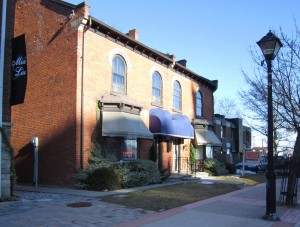 Pearl Street Cafe was a recent Carnacelli property acquisition – part of a small land assembly that reaches down to Lakeshore Road. ECoB believes this proposal is the most obvious case yet of over-development in downtown Burlington. While we hope, and aspire, to work collaboratively with developers to make their proposals align better with residents’ objectives, there seems little way in which this development, even if scaled dramatically back, would reflect the democratically expressed preferences of the residents of Burlington.
We believe this development is likely to be a test case, not just for the new council, but for the role of municipalities and local democracy in Ontario. The outcome will tell us much about the power of municipalities versus the power of developers to demand, and receive, approval for developments which bear no relation to legally adopted and provincially endorsed Official Plans.
Roland Tanner is an academic, a community activist, a member of the Shape Burlington Report committee and a candidate in the last municipal election. He is also vice chair of ECoB and has a very dry sense of humour

 By Staff By Staff
February 23rd, 2019
BURLINGTON, ON
This specific highway traffic incident didn’t happen in Burlington – but the same kind of driving stupidity happens here as well.
See what the consequences are when someone gets really stupid behind the wheel of a car.
 Following a complaint of aggressive driving made to the Halton Regional Police “Road Watch” program, Regional Police Officers were tasked with an early morning patrol to try and catch an unknown driver. Following a complaint of aggressive driving made to the Halton Regional Police “Road Watch” program, Regional Police Officers were tasked with an early morning patrol to try and catch an unknown driver.
The complaints alleged that the driver was routinely operating a black VW Jetta sedan and was driving at speeds in excess of 100km/h, and on one occasion was seen passing up to 15 vehicles.
On February 21st 2019 at approximately 05:30hrs a DRT Officer observed the suspect vehicle passing vehicles in a southbound direction travelling at 132km/h in a 60km/h zone.
The vehicle was stopped and was confirmed as the same vehicle as having been reported in the Road Watch complaint.
The driver was charged with the following offences:
1. Stunt driving
2. Speeding – 132km/h in a 60km/h zone
3. Fail to have insurance card
The drivers licence and vehicle were seized for 7 days. A request for a drivers licence review by the Ministry of Transport was also approved. Ouch – that will hurt.
The Road Watch on line reporting tool can be accessed here.

 By Staff By Staff
February 23, 2019
BURLINGTON, ON
 Conservation Halton advises that areas of the watershed are forecast to receive 5 to 10 mm of rain beginning Saturday evening. Conservation Halton advises that areas of the watershed are forecast to receive 5 to 10 mm of rain beginning Saturday evening.
Rain is expected to continue overnight into Sunday with an additional 5 mm possible. In addition, air temperature is expected to rise to approximately 2 Degrees Celsius on Saturday and increase up to 10 Degrees Celsius on Sunday before dropping back to below freezing through next week.
The forecasted precipitation combined with melting snow due to warmer temperatures will result in increased water levels and flows within our rivers and streams over the next several days. The combination of slippery and unstable banks, unsafe ice and cold water temperature will create hazardous conditions close to any river, stream or other water bodies.
 Conservation Halton advises that rain expected has the potential to flood the creeks. In addition, any remaining ice cover may breakup resulting in blockages at bridges and culverts producing localized flooding concerns in low lying areas.
Widespread flooding is not anticipated, however, fast flowing water and flooding of low lying areas and natural floodplains may be expected.
Conservation Halton is asking all residents and children to stay off ice covered bodies of water and keep a safe distance from all watercourses and structures such as bridges, culverts and dams. Elevated water levels, fast flowing water, and slippery conditions along stream banks continue to make these locations extremely dangerous.
Please alert children in your care of these imminent dangers.

 By Staff By Staff
February 23rd, 2019
BURLINGTON, ON
We are going to get through this winter.
 The people at the Art Gallery are so certain that we will they have announced “ officially “ that Spring + Summer Program Registration opens Wednesday, March 13! The people at the Art Gallery are so certain that we will they have announced “ officially “ that Spring + Summer Program Registration opens Wednesday, March 13!
You can register online at agb.life/springsummer2019 , by phone at (905) 632-7796, or in person at our Brock Lobby Front Desk!
The people who pump out the news at the AGB have said that: “If you heard that registration was starting on another date, ignore those rumours! In order to give you the best registration experience possible, we moved the time. We’re so sorry for any inconvenience this change may cause!

 By Mayor Marianne Meed Ward By Mayor Marianne Meed Ward
February 22nd, 2019
BURLINGTON, ON
Mayor Marianne Meed Ward released the basics of a letter she received recently from the Minister of Municipal Affairs and Housing. We will let the Mayor speak for herself.
My office recently received a letter from Minister Steve Clark of the Ministry of Municipal Affairs and Housing regarding their work on the provincial government’s Housing Supply Action Plan.
Minister Clark outlined their desire “to take swift action to streamline the development approvals system” and “speed up the time it takes to get the right kind of housing built in the right places”. He further explained that “land use planning and development approvals are critical to achieving housing and job- related priorities” in our communities.
I agree with these assertions and am glad to see their continued commitment to expediting these processes. As part of the new Red Tape Red Carpet Task Force that my office has initiated to support local business attraction and growth, I am committed to cutting red tape for development applications that are supported by council and the community.
The Minister’s office continues to consult on proposed changes to the Growth Plan for the Greater Golden Horseshoe and review the Planning Act and Provincial Policy Statement as well, with the intention to bring forward legislation and policy changes in the coming months.
While Minister Clark’s letter advises local municipalities to consider pausing on activities that may be impacted, such as Official Plan reviews, I want to reinforce that until we get more specific details from the Province related to the municipal land use planning process, the City of Burlington will continue to move forward as planned with our review of the Official Plan as per the motion approved by City Council on February 5th.
On a related matter, I am disappointed to learn today that the province has announced the June 30th closing of the Local Planning Appeal Support Centre (LPASC), a resource that offers support to the public in navigating both land use planning matters and the Local Planning Appeal Tribunal. Public participation, a vital part of democratic community planning, should not be sacrificed in the name of ill- defined or non-existent efficiencies.
The best way to save time and money is to eliminate the Local Planning Appeal Tribunal altogether. The tribunal, like the Ontario Municipal Board it replaced, provides unelected and inefficient involvement in planning matters that are best left to local councils, unnecessarily slowing down the development process.
Leaving planning in local municipal hands would not only speed approvals and remove red tape, but also provide more incentives to the development industry to work with municipalities and their residents to plan full communities rather than just build housing.

 By Pepper Parr By Pepper Parr
February 22nd, 2019
BURLINGTON, ON
The Gazette keeps hearing about problems at the Seniors’ Centre on New Street. For the most part they are small niggling little issues but when collected together they suggest there is a deeper issue.
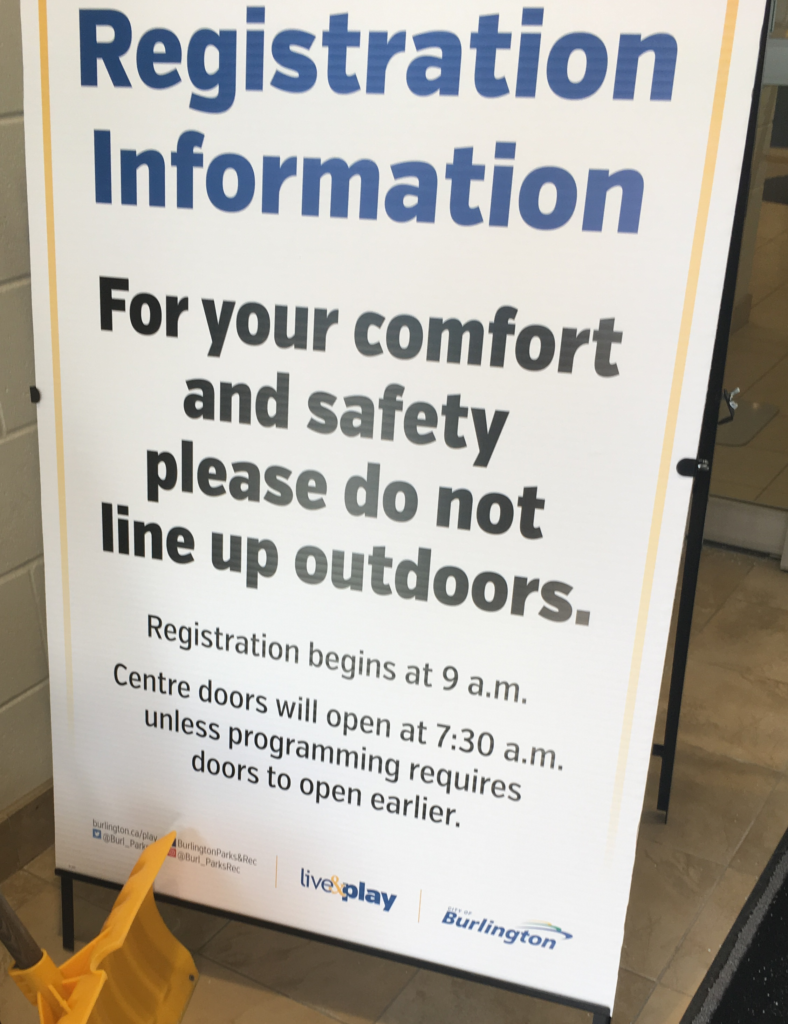 Seniors’ Centre staff showing their concern for the comfort and safety of people who use the facility. Do the staff really care about the people they are supposed to be serving?
These are seniors; the people who have paid their dues and have the right to quality time and more than just a measure of dignity.
The week was registration week – the Gazette published a news report on some of the problems that were being experienced with the registration process and the impact a change in the way programs are paid for was having on some people.
Earlier today we were sent a photograph of a sign that had been set up outside the entrance door advising: For your comfort and safety please do not line up outdoors.
The doors should be opened as early as possible so that the seniors can be both safe and comfortable.
There is a care taker in the building – he could unlock the doors and people could wait in the auditorium.
People get to the Centre as early as possible so they can obtain a number and be in the registration line based on the number they hold. These people want to take courses – many of them that are exercise classes. They want to remain healthy and active – but the staff seem to want them to stand out in the cold.
Burlington is a city that talks about the way it cares for its citizens but refuses to open the doors to a public building so that older people can get inside and stay out of the chilly if not downright cold weather.
What is wrong with these people?
Related news story:
Empathy appears to be in short supply as Seniors’ Centre

 By Staff By Staff
February 22nd, 2019
BURLINGTON, ON
If music played on a piano is something you enjoy – and if that music is classical at its very best – mark March 10th on your calendar and log into the Performing Arts Centre web site to book tickets.
 Gryphon Trio: Piano, with Strings Attached Throughout the 2018/19 season, BPAC is celebrating The Piano, presenting a four-concert series showcasing this magnificent instrument in distinct piano presentations, with some of Canada’s keyboard masters. GRYPHON TRIO: Piano, with Strings Attached is the latest installment in the concert series.
One of the most accomplished piano groups in the country, described as Canada’s foremost Piano Trio will be on stage at BPAC for a 1:00 p.m. and a 7:00 pm performance that will include:
Haydn’s Piano Trio in G Minor, Beethoven’s Piano Trio in E-flat Major, and after intermission, they will be joined by a guest violist to perform Brahms’ Piano Quartet No. 1 in G Minor, one of the quintessential Romantic piano chamber works.
Throughout the 2018/19 season, BPAC is celebrating The Piano, presenting a four-concert series showcasing this magnificent instrument in distinct piano presentations, with some of Canada’s keyboard masters. GRYPHON TRIO: Piano, with Strings Attached is the latest installment in this poignant concert series.
 Gryphon Trio in concert: Roman Borys, Annalee Patipatanakoon, and Jamie Parker. The multiple JUNO-winning Gryphon Trio returns to Burlington to perform chamber piano masterpieces. This year, the Gryphon Trio celebrated its milestone 25th anniversary. Throughout their history, they have firmly established themselves as one of the world’s preeminent piano trios, garnering acclaim and impressing international audiences with its highly refined, dynamic and memorable performances.
The trio is made up of Roman Borys, Annalee Patipatanakoon, and Jamie Parker. Roman is the Artistic and Executive Director of the Ottawa Chamber Music Society, Annalee and Jamie serve as OCMS’s Artistic Advisors in addition to their responsibilities at the University of Toronto’s Faculty of Music, where Jamie is the Rupert E Edwards Chair in Piano Performance and Annalee is the Associate Professor of Violin and Head of Strings.
GRYPHON TRIO: Piano, with Strings Attached
Sunday, March 10, 2019, 1:00pm & 7:00pm
Main Theatre
440 Locust Street, Burlington, ON, L7S 1T7
Tickets:
$49 Regular
$44 Member
Group pricing available
*All prices include tax and fees.
To Purchase Tickets:
Online: www.burlingtonpac.ca
Over the Phone: 905.681.6000
In Person: Monday – Saturday, 12:00pm -4:00pm, or 1 hour before the show

 By Staff By Staff
February 22, 2019
BURLINGTON, ON
This will come as a bit of a jolt to anyone who wants to be involved in appeals to decisions made by city council on development applications.
A Gazette reader sent us a notice she got from the Local Planning Appeal Support Centre advising her that: “The Government of Ontario has made a decision to close the Local Planning Appeal Support Centre (LPASC). LPASC has until June 30, 2019 to wind down the business.
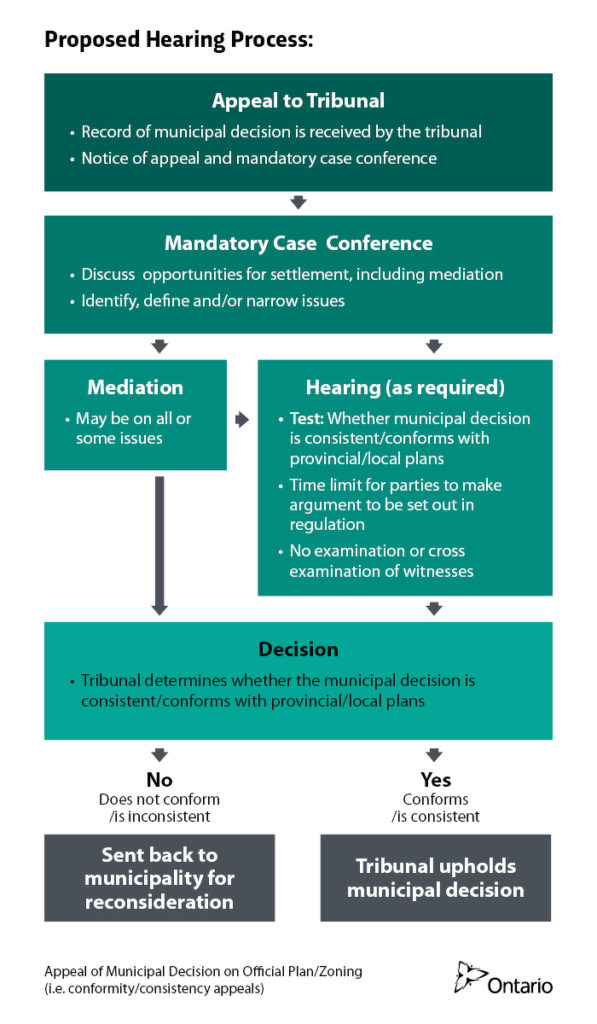 So much for process – how do people navigate through the paper work and the procedures? Effective immediately, LPASC will no longer be accepting new requests for professional services from the public. During this wind down period, LPASC is committed to continuing to serve, to the best of its ability, those clients who have retained its services. LPASC staff will be in contact with those clients with further details shortly.
If you have any questions, please send an email to info@lpasc.ca <mailto:info@lpasc.ca> or call 1-800-993-8410.
The questions should also be directed to Burlington’s Member of the provincial Legislature. You might ask just how this decision came about.

 By Staff By Staff
February 21st, 2019
BURLINGTON, ON
Registration for both 2019 Spring and Summer recreation programs opens February 23, 2019 for Adults 19+ and 55+. People can register for both programs at 9 a.m., doors will open at 7:30 a.m. for early arrivals.
Registration is available online at burlington.ca/play, in-person at Burlington Seniors Centre, Tansley Woods and Brant Hills Community Centres, or City Hall. Non-residents will be able to register on March 1, 2019.
 The Spring/Summer Live and Play guide, featuring listings for city recreation, sport and culture programs is available online on the City of Burlington website. Printed copies of the guide are available at City Recreation Facilities, City Hall and the Burlington Public Libraries. The Spring/Summer Live and Play guide, featuring listings for city recreation, sport and culture programs is available online on the City of Burlington website. Printed copies of the guide are available at City Recreation Facilities, City Hall and the Burlington Public Libraries.
The spring session programs begin April 1 and the summer programs will begin on July 8.
Following registration day, in-person registration is available at any customer service location. A listing of locations and hours is available at burlington.ca/servicehours.
For those choosing to register for both spring and summer programs, the option for a deferred payment for summer registration is available. Customers can access this payment option by registering in-person.
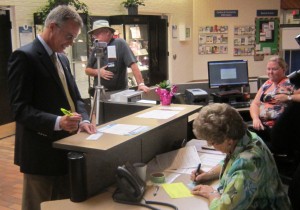 Senior citizen former Mayor Rick Goldring signs up as a member at the Senior’s Centre. Today was program registration day. The City of Burlington would also like to remind residents financial help is available through the Recreational Fee Assistance program for those that qualify.
Recreation Fee Assistance
Recreation Fee Assistance is funding made available to individuals or families who need help to pay for City of Burlington recreational programs.
Fee Assistance can be used for:
• Registered Programs
• Drop-In Programs
• Passes and Memberships
One Gazette reader explained that at a class at the Seniors’ Centre “we were told that the City had decided that moving forward there will be only 2 registration periods. This will start with the February 23rd Registration.
How this will work is as follows: On February 23rd seniors will be registering for programs. Seniors will be able to register for the spring session and/ or the summer session. Some of the classes have very limited space availability and if they don’t register for both in February chances are they won’t get into the class in the summer.
For some residents having to pay for both the spring and summer session could be problematic. We were also told that if the Senior’s membership to the Centre expired before the end of the last class the computer would basically kick them out and they will not be registered in the course. So it would mean that the senior has to pay for both sets of sessions plus the membership fee. Also the City is holding their money for months before completing the session.
We were also told that for those seniors who come into the centre to register, if they could not pay for everything at once arrangements could be made.
What about those seniors that register at home online – they do not have this option of spacing out their payment? More seniors register online, why should this option not be made available to them?
For those seniors who are away ( snowbirds) how will they know that the summer registration starts on February 23rd.
The reader made the point that “once again decisions seem to be made that are not discussed in advance with those who are most affected by these changes.”
 “Parks and Rec tried to make seniors bring their own equipment for Pilates (like large Pilate balls and bands) starting in the Spring and only when this came to light and reported on did Parks & Rec back down. “Parks and Rec tried to make seniors bring their own equipment for Pilates (like large Pilate balls and bands) starting in the Spring and only when this came to light and reported on did Parks & Rec back down.
There appear to be a number of administrative level issues within Parks and Recreation when it comes to how the Seniors’ programs are managed. The issue seems to be at the leadership level – staff do not appear to be very empathetic to the issues seniors face.

 By Staff By Staff
February 21st, 2019
BURLINGTON, ON
It looks as if the Interim is still the Interim and not the Acting.
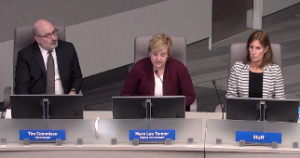 During the Capital Budget Standing Committee meeting today Tim Commisso was addressed as the Interim City Manager. A couple of chuckles were heard from the Staff Section of the council seating. During the Capital Budget Standing Committee meeting today Tim Commisso was addressed as the Interim City Manager. A couple of chuckles were heard from the Staff Section of the council seating.
No one has said anything about how the title “Acting” got attached to Commisso’s name – clerical error perhaps?
The budget meeting went exceptionally well. The performance put in by Ward 4 Councillor Shawna Stolte on handling two very complex financial issues – Information and Technology and the Fire department, were lengthy but very well done.
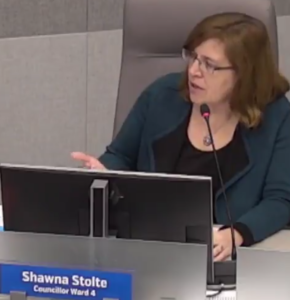 The financial requirement for Information Technology was in the millions and brought to light some serious issues that were not known or discussed at anything length at previous budget meetings. The financial requirement for Information Technology was in the millions and brought to light some serious issues that were not known or discussed at anything length at previous budget meetings.
This council is made up of younger people who are not afraid to ask questions and id they aren’t comfortable they ask a follow up question.
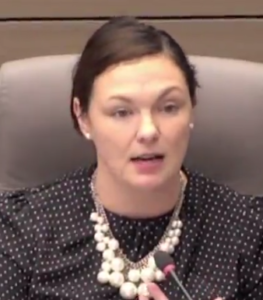 Budget Committee Chair Lisa Kearns Budget Committee Chair Lisa Kearns was able to match the staff member explaining the technology word for word – she has been down that road before. They also managed to take a decent amount of money out of the Capital budget – they are determined to get any tax increase below 3% – given the rate at which they moved today – you can think in terms of something well below that 2.99% Mayor Meed Ward put on the table.
There is a different tone from this council.

“First I want to say these allegations are false. Categorically untrue. Every one of them.” (Patrick Brown, CTV News- January 24, 2019)
 By Ray Rivers By Ray Rivers
February 20th, 2019
BURLINGTON, ON
Part 4 of a four part article
 Patrick Brown is made leader of the Progressive Party. Sir Isaac Newton taught us that what goes up must come down. But that doesn’t always mean the faster you climb up the political ladder the faster you’ll tumble down. Though it did for Patrick Brown, if being ‘down’ includes ending up as mayor of the sizeable city of Brampton, instead of premier.
Over a year has passed now since Brown was forced out as Ontario PC leader. And if, as he contends, this was a political assassination by his own party, the question is why nobody but me is talking about it. The entire issue has virtually disappeared from the mainstream news. Perhaps it’s because the PCs are able to do a better job of changing the message than their Liberal colleagues. So maybe we’ve got this pro-liberal media bias thing wrong.
Just look at how a single speculative allegation in the Globe and Mail, about the prime minister’s office and the federal Attorney General (AG), has led to resignations, including that of the second most powerful person in Justin Trudeau’s government – Gerald Butts.
News is what’s in the newspapers. But there is zero evidence that anything illegal or even improper happened. Denials abound of direction-given and pressure-applied to the AG, and SNC is still going to court rather than getting its plea bargain. The only story here is how the media and opposition parties are colluding to ruin Trudeau’s chances in the upcoming election.
 Brown being chased by media after announcing his resignation as leader of the Progressive Conservative Party. There are troubling similarities with regard to the CTV report which ended Brown’s leadership of the Ontario Progressive Conservative party. The allegations that Brown, the teetotaler, had plied an under aged girl with booze for sex were false on at least a couple of counts. For one thing the girl wasn’t underage and she admitted that the sex had been consensual. It was an inaccurate story which the network retracted, amended, and corrected; and over which Brown is now suing them for eight million big ones.
If this wasn’t a total conspiracy it sure looked, smelled and behaved like it. No sooner had the CTV story broken than Brown’s key caucus members convened for a conference call, without Brown. And when Brown finally got wind of the call and joined in, they had one message for him – just resign and now. They weren’t interested in his side or the story. They had the smoking gun so who needed to wait for the finger prints to come back from the lab.
Then there were the staff resignations, almost on cue in a perfectly orchestrated pincer movement – the perfect trifecta for an almost instantaneous bring down. His three top advisors led the stampede with…“Earlier today, all three of us became aware of allegations about Patrick Brown. After speaking with him, our advice was that he should resign as Ontario PC Party leader. He did not accept that advice.”
 Alykhan Velshi, Brown’s chief of staff is a brilliant 30-something lawyer and policy analyst with credentials from the London School of Economics. He spent his formative years developing his skills as a neoconservative, first at the American Enterprise Institute and the Foundation for the Defence of Democracies, then as a political operative in the government of former PM Stephen Harper. Alykhan Velshi, Brown’s chief of staff is a brilliant 30-something lawyer and policy analyst with credentials from the London School of Economics. He spent his formative years developing his skills as a neoconservative, first at the American Enterprise Institute and the Foundation for the Defence of Democracies, then as a political operative in the government of former PM Stephen Harper.
Velshi has an impressive political resume, working in Harper’s office and also advising ministers John Baird and Jason Kenny. In fact Brown had hired him on the strength of his time with Kenny. And Brown should have known that was going to be trouble. Kenny, the ultra-conservative, and Brown, the political centrist, never saw eye to eye, particularly after Kenny virtually blackmailed the MP Brown into voting against his will on an issue.
And Velshi is as far right wing politically as Brown is firmly in the center of today’s political world. Velshi had been responsible for developing the Tory opposition strategy to Liberal leader Stephane Dion’s ‘Green Tax Shift’ carbon tax proposal back in the mid 2000’s. How was he now supposed to get behind Brown’s policy of implementing a comparable carbon tax?
But Velshi swore up and down that he was on-side with fighting climate change and a carbon tax. That would have been a 180 degree turnaround from his earlier days peddling fellow ultra rightist Ezra Levant’s oxymoronic notion of ‘ethical oil’. But he was not the only obviously disingenuous Tory signing onto Brown’s policies.
 In fact almost all of caucus officially supported Brown’s ‘People’s Guarantee” which was endorsed at the party’s November 2017 policy conference. Though Velshi’s previous mentor, Albertan Jason Kenny, stormed out of the conference once he realized that a carbon tax was one of those policies. In fact almost all of caucus officially supported Brown’s ‘People’s Guarantee” which was endorsed at the party’s November 2017 policy conference. Though Velshi’s previous mentor, Albertan Jason Kenny, stormed out of the conference once he realized that a carbon tax was one of those policies.
There is no more reasonable explanation for what happened to Brown than the way he himself penned it in his book. If it wasn’t a set up, then we’ve all been watching too much TV, or too little. This was a perfect trifecta: mutineer-minded staff, a treacherous caucus and a damning news story.
Almost immediately after the CTV report Brown became a toxic commodity – an outcast ironically from the very party he had restored out of the ruins left him by former leader Tim Hudak. Brown was eventually evicted from caucus, disallowed candidacy to run again as MPP, and even refused the opportunity to run for Chair of Peel Region after Ford cancelled that election. Kathleen Wynne had been treated better.
Brown’s book may help identify the ‘how and why’, but it might take another book to identify the ‘who’ – who were the actual manipulators of this conspiracy. Doug Ford ended up the big winner – he wasn’t even in caucus back then. Carolyn Mulroney picked up some of his staff, but lost her bid anyway in the leadership campaign. And pretenders to the throne, Vic Fedeli and Christine Elliott, were left just out of the winners circle once again.
Brown’s former chief man Alykhan got his old job back working for interim leader, Vic Fedeli, until the provincial election when he got himself sweet-hearted into a plum job at Ontario Power Generation. Except that, in a puzzling move, Ford’s own chief of staff indirectly fired Alykhan before he’d even sat down at his new desk.
Perhaps, like the Mafia, the Ontario PCs like to bury the bodies of their worn out operatives themselves. And on that count , despite the law suits, this whole affair was just an internal thing, a PC family matter.
Maybe that is the real reason why it’s not in the news anymore?
Background material:
Brown Denial – Insane Month – Brown Defence Statement –
Brown’s Book – Ethical Oil – Alykhan Velshi –
Fired from OPG
 Ray Rivers writes weekly on both federal and provincial politics, applying his more than 25 years as a federal bureaucrat to his thinking. Rivers was a candidate for provincial office in Burlington where he ran against Cam Jackson in 1995, the year Mike Harris and the Common Sense Revolution swept the province. He developed the current policy process for the Ontario Liberal Party. Ray Rivers writes weekly on both federal and provincial politics, applying his more than 25 years as a federal bureaucrat to his thinking. Rivers was a candidate for provincial office in Burlington where he ran against Cam Jackson in 1995, the year Mike Harris and the Common Sense Revolution swept the province. He developed the current policy process for the Ontario Liberal Party.
Previous parts of the four part article.
The political take down of Patrick Brown – Part 1
Rivers on Patrick Brown – He said – she said – Part 2
Rivers on Patrick Brown – Part 3

 By Pepper Parr By Pepper Parr
February 21st, 2019
BURLINGTON, ON
Just how does the city budget get created and passed and what do the members of council do to ensure that tax payers are getting value for money?
Staff in the Finance department present a draft budget to city council
That draft is the result of a process that has each department putting together their budgets which gets vetted by a team that consists of senior staff, the Director of Finance and the city manager.
The public get to delegate on the draft budget.There was email feedback, there was a telephone town hall, the city made use of its Get Involved service that lets people say what they think on various issues. And then there was that button-holing that politicians have to live with from residents who want something for their special interest or community.
Members of Council inevitably have questions – with the current five new members of Council there is not only a steep learning curve but also a lot of questions that are often specific to their wards.
The following is a list of some of the questions individual council members asked. The name of the council member who posed the question is not provided – unfortunately.
Service: Recreation
Question: Securing Sponsorship Funds by Naming Corporate Assets
Who is responsible for generating sponsorship funds through the naming of corporate assets?
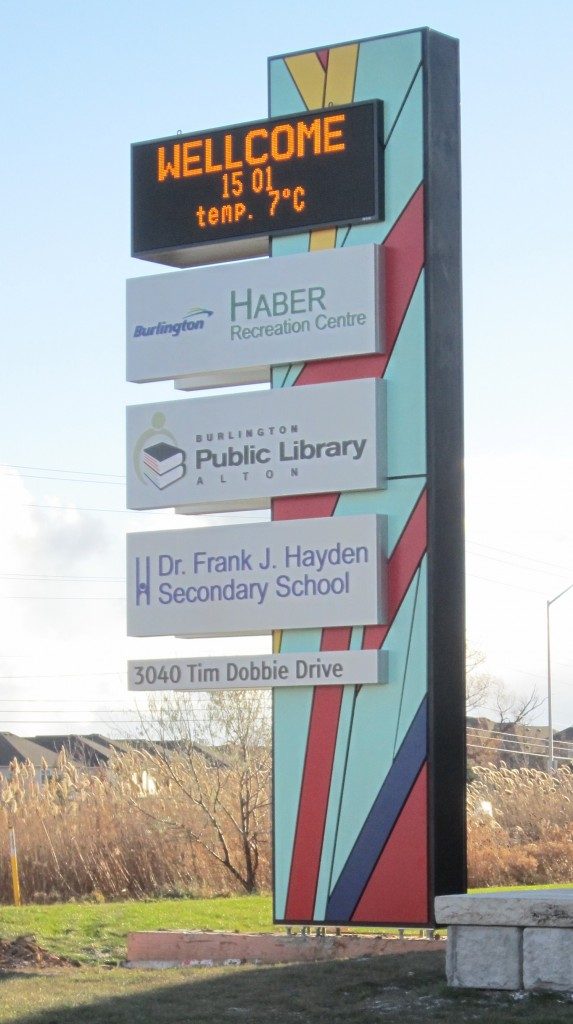 The Haber Law Group got naming rights to the Recreation Centre in Alton for 20 years – paid millions. Response: To date, naming opportunities have been done on a project by project basis with Parks and Recreation staff usually taking the lead. A sponsorship package is approved by council and potential sponsors are sought. Most recently the city was successful in securing a naming opportunity for the Haber Recreation Center; unsuccessful in securing a sponsor for the renovated Nelson Outdoor Pool.
Funds secured are placed in a reserve to support future capital renewal of the asset that was named. There have been differences of opinion on whether the city should secure sponsorship for the overall name of an asset, with there being more comfort with naming components within an asset.
A review of the corporate sponsorship policy will be undertaken later in 2019, early 2020
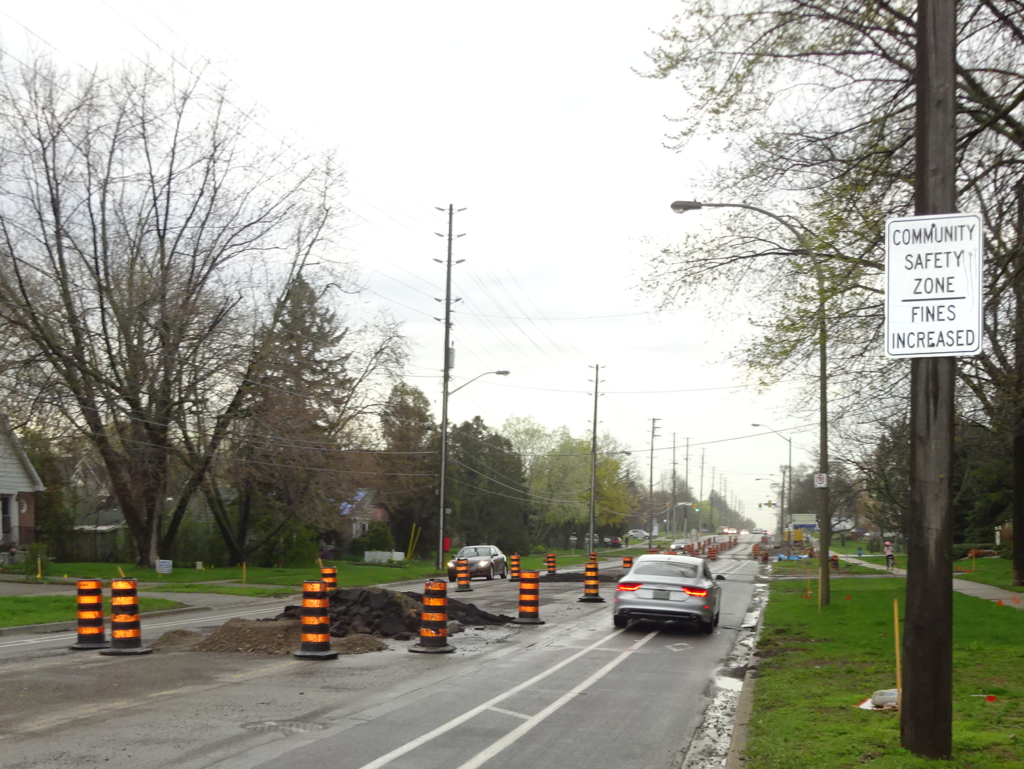 It was Regional budget dollars that paid for the re-build of New Street. Infrastructure no matter who pays – in the end it is coming out of your pocket. Question: What would be the impact on the overall 20-year asset management plan if the increase in the infrastructure renewal levy was decreased to 1% instead of 1.25% for this year, and what is that amount worth?
Response: A 0.25% decrease would reduce $400,000 of funding to the capital program in 2019 and $8 million of funding over the next 20 years ($24 million over the 60-year Asset Management Plan). $4 million of projects would need to be removed from the 10-year capital budget and forecast.
The capital projects impacted by the reduction risk higher costs in the future to complete and additional costs by the way of minor maintenance expenditures until the work can be done. The projects timing in the capital program is based on assessed condition, warranting the required work, deferring work can impact the resident’s experience and derived quality with the asset.
Question: Provide a list of statutory and discretionary development charge exemptions and a list of ineligible services.
Response: List of statutory and discretionary development charge exemptions and list of ineligible services:
The Development Charges Act along with regulation O.Reg. 82/98 provides legislated statutory development charge exemptions for the following:
• Industrial building expansions up to 50% of the gross floor area
• Intensification within existing residential developments with up to 2 additional dwelling units permitted within existing low-density dwellings and 1 additional dwelling unit permitted within medium and high-density dwellings
• Municipalities (City and Region)
• Board of Education and local board, as defined in the Education Act
The City’s existing DC by-law (46-2014) also provides non-statutory exemptions from payment of development charges with respect to:
• Hospital, excluding any portion of the lands, building or structures occupied by the tenant of the hospital
• A place of worship
• Conservation authority
• Seasonal structure and temporary venues
• Parking garages
• Agricultural uses
• Canopy (structure with one or no walls, ie. Gas pump islands)
Ineligible services:
In accordance with the Development Charges Act and O. Reg 82/98, a development charge by-law may not impose development charges to pay for increased capital costs, prescribed as ineligible service listed below:
• Cultural or entertainment facilities, including museums, theatres and art galleries
• Tourism facilities, including convention centres,
• Acquisition of land for parks, including woodlots
• Hospitals, as defined in the Public Hospitals Act
• Landfill sites and services
• Facilities and services for the incineration of waste
• Headquarters for general administration of municipalities and local boards
• Lands for parks, includes land for woodlots and land because it is environmentally sensitive
Project: Funding for Capital Projects from Parks and Recreation Reserve Funds
Question: How are the reserve funds managed and what amount of funding is coming from them for capital projects?
Response: The Parks and Recreation Department utilizes reserve funds to partially support capital initiatives for the repair and renewal of facilities and associated program amenities/enhancements in the Organized Sport Support, Recreation and Culture service areas.
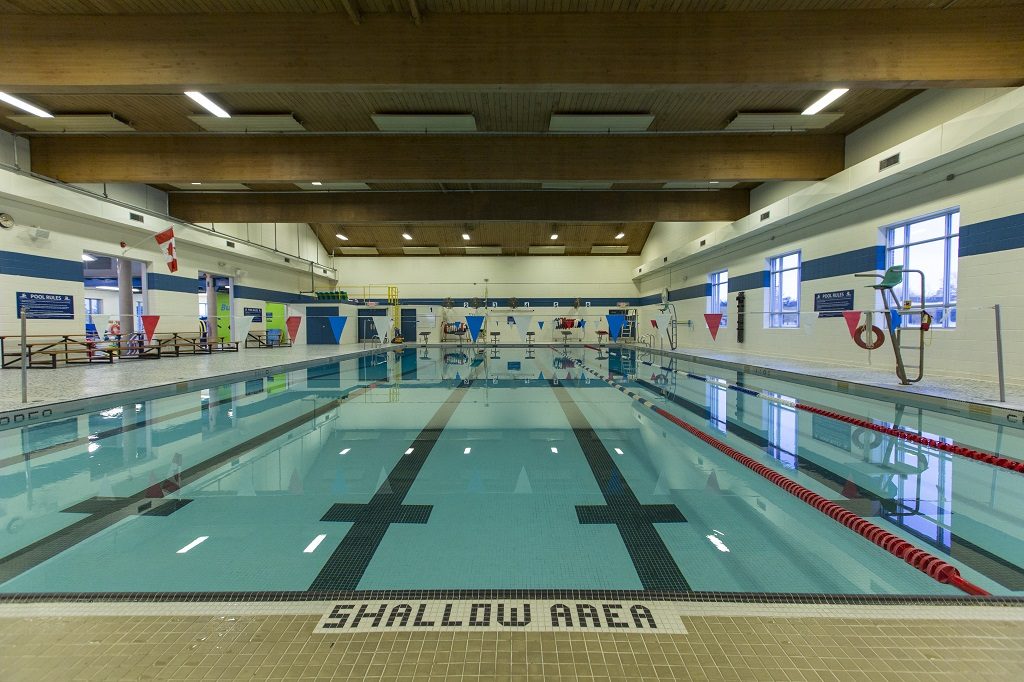 Angela Coughlan Pool Reserve Funds related to facilities and programs are funded by a 5% surcharge place on user fees. Funds from these Reserve Funds are used to offset a portion of capital costs related to repair, renewal and enhancement of facilities and programs in the asset type, for example; surcharges collected at Angela Coughlan Pool would be placed in the “Pools” Reserve Fund and used for pools asset renewal projects.
Projects presented through the capital budget that are funded or partially funded through Reserve Funds illustrate details as such under the budget summary.
Service: Municipal Law Enforcement (additional By-law Enforcement
Question: Bylaw: getting from 6 (proposed budget) to 8: I understand Parks and Recreation have a parks enforcement office, and parking enforcement is also separate from bylaw. Can we redeploy a parks and rec, and a parking officer to bylaw to bring the total bylaw complement to 8 officers? Or redeploy one officer from animal control to bylaw to achieve one of the 2.
Response: Parks and Recreation have Park Ambassadors who work with sports groups on proper park etiquette and problem-solving issues (lights on, lights off etc). These are part- time staff who work in summer months.
Parking Enforcement is contracted out to a 3rd party provider (Core Commissionaires) and the enforcement officers are not City employees.
Moving an animal enforcement officer would result in service reductions to customers and Animal Control Enforcement overall. This would impact the work the animal enforcement officers do on investigations, ticketing, and coyote management (as examples).
Service: Road and Sidewalk Maintenance
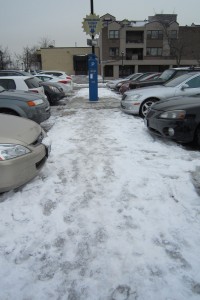 Would this stretch of sidewalk qualify? Question: What would be the cost of plowing the pathway at Brant Hills Community Centre? Are there any other locations not currently maintained in the winter?
Response: The additional cost to maintain this pathway is minimal and could be accommodated however there are significant safety concerns during freeze/thaw conditions given the hilly nature of the pathway.
There is a further 57 km of footpaths not in the road allowance that are not maintained in the winter. To maintain all of these pathways in the winter would require significant resources including additional staffing and capital equipment.
Given the significant amount of work and resources required to partially implement the new minimum maintenance standards on sidewalks adding additional footpaths is not recommended at this time.
Service: Transit
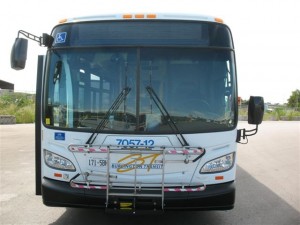 What would free transit cost the city? Question: What is the cost to provide seniors with free transit between 9:30 am and 3:30 pm Monday to Friday?
Response: The estimated cost is $300,000 for conventional transit and $60,000 for para-transit service.
Service: Recreation
Question: What expansion have we done to the pickleball program to address demand?
Response: We have been successful at obtaining grant funding to support a program expansion at various locations throughout the city. To date, we have also considered partnering to maintain this program expansion as well as looking to convert outdoor tennis courts, in specific target areas, to outdoor pickleball courts. Funding ends after this year. To date, all program expansions have had to be funded by grants which is not sustainable.
Service: Recreation and Organized Sports
Question: Have we been able to meet the community need in terms of fee assistance and other similar type requests?
Response: To date, we are able to meet the demand we receive through the various funds available such as Community Matching Fund, Fee Waiver and Fee assistance programs. Financial assistance is supported in part by the tax base and also by external funders / donors.
Service: Local Boards
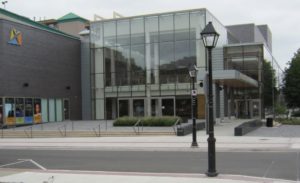 Performing Arts Centre get a substantial subsidy. Question: What savings would be achieved by holding the boards and Committees to 1.5% across the board instead of 2%?
Response: The total savings of reducing the city’s contribution to the local boards to a 1.5% increase instead of a 2% increase would be $75,457 as detailed below:
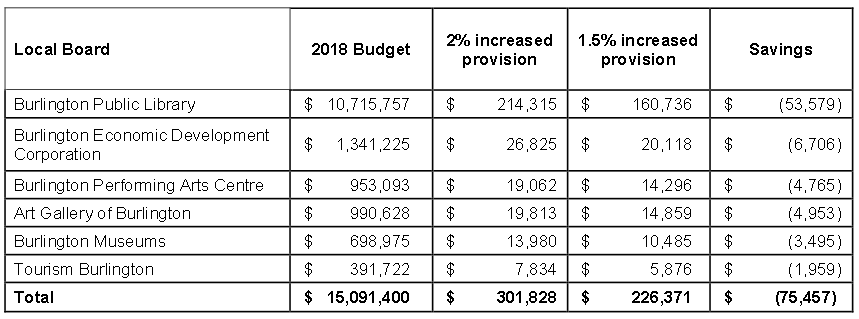
Service: Corporate Expenditures (VDRF)
Question: Can the provision to VDRF (Vehicle Depreciation Reserve Fund) be reduced? Showing a $402K increase.
Response: The Vehicle Depreciation Reserve Fund is used to fund the replacement of the city’s Fleet vehicles (excluding conventional buses). The policy approved in 2018 is to increase the provision by 4% annually. In addition, $270,000 of tax supported funding previously required for debt charge repayment (see $500k reduction in debt charges) was restated to support the Handi-van renewal requirements. Handi-vans were previously replaced using funding from gas taxes.
Service: General – HR Budget Summary
Question: Why is HR up 7.1%? Is this the head count increase?
Response: 7.1% HR increase includes business case requests as well as the base budget. Base budget increase is 4.8% and when you exclude the regulatory/contractual obligations as well as the 2 staff for Halton Hills fire communications and the road patroller that is funded by the Region, the base budget increase for HR is 3%.
Question: What is the total amount of budget reductions required to get the increase to 2.99%?
Response: $1.6 million of on-going savings would be required to reduce the proposed budget from 3.99% to 2.99%.
The challenge for this new city council is determining what will be cut? Will this council focus on projects in their wards or will they take a longer term approach and structure the budget to ensure that the public gets value for the money spent.
We will report on that debate which takes place today.
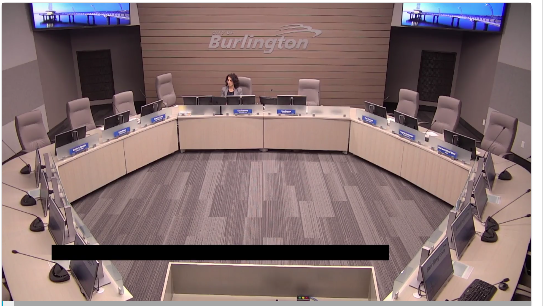 The seven members of city council who sit in this renovated council chamber will decide just what your tax bill is going to amount to. 
 By Pepper Parr By Pepper Parr
February 20th, 2019
BURLINGTON, ON
 Ward 2 Councillor Lisa Kearns – possibly a real McCoy. We knew she was going to be different when she made that “phony baloney” comment at one of her early ward meetings. Ward 2 Councillor Lisa Kearns was talking about the “stuff that was coming out of the Transportation department.
When when she turned to the Clerk at one of her early budget meetings and asked: “Do I talk now” we were seeing the real McCoy.
During the first month she was in office Kearns said that she was going to create a Business Registry. Anyone wanting to talk to her about a business matter would have to sign the Registry so that her constituents would know who she was talking to. We don’t yet know how detailed that Registry is going to be – just that there will be one and that it will become public starting at the end of March.
Here is what Ward 2 City Councillor Lisa Kearns has on her city hall information page:
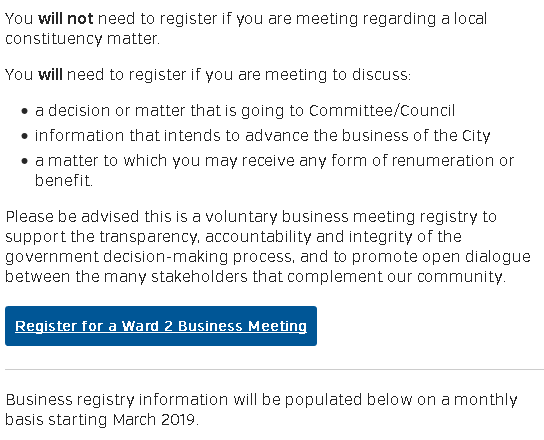
How many of the other council members have said they will create a Registry? Has the Mayor created a Registry for the people that ask to meet with her?
The next Ward 2 Community Update meeting:
Thursday, Feb. 28 2019
7 p.m. – 8 p.m.- doors open at 6:30 pm at the Burlington Public Library, Holland Room – 2331 New Street.

 By Staff By Staff
February 19th, 2019
BURLINGTON, ON
 The Halton Regional Police is warning citizens against several telephone scams that are operating within the region. Over the past few weeks, residents have reported receiving calls with the following themes: The Halton Regional Police is warning citizens against several telephone scams that are operating within the region. Over the past few weeks, residents have reported receiving calls with the following themes:
Scam #1:
Caller indicates they are from the CRA (Canadian Revenue Agency) and that you owe money for taxes. In some cases, the suspect tells the victim a warrant will be obtained and they will be arrested if they do not make an immediate payment. Payment is requested in the form of gift cards that are not traceable (Amazon, iTunes, Google Play). The victim attends a store, purchases a large quantity of gift cards and gives the caller the personal identification number (PIN) or verification number.
Scam #2:
Caller indicates they are from your bank and need help to investigate an internal fraud between the bank and another retail store. You have been selected to assist with the investigation and could earn up to $500.00 for your help. The caller then directs you to purchase a large quantity of gift cards (Amazon, iTunes, Google Play, Walmart) and call them back with the PIN. You are told where to purchase the gift cards and cautioned not to disclose the reason or directed to say you are purchasing the cards as gifts for your children or grandchildren. Suspect may also gain remote access to victim’s computer (online banking). The promised deposit appears in their daily banking account; however, it is transferred from victim’s line of credit/savings unbeknownst to victim.
Scam #3:
Caller identifying themselves as a bank employee and advises you that one of your credit cards has been compromised. The caller indicates they will deposit a large sum of money into your account (much larger than what you are alleged to have lost), however, you are asked to transfer back a portion of the money. Suspect may gain remote access to victim’s computer (online banking). The promised deposit appears in their daily banking account; however, it is transferred from victim’s line of credit/savings unbeknownst to victim.
Scam #4:
Caller indicates they are with some type of police or other law enforcement agency, or a lawyer representing a loved one (they will often use a grandchild and elicit a promise “not to tell” anyone). The caller directs you to initiate a money transfer. The caller is often asking for thousands of dollars to “post bail” for your loved one. Older adults are often the target of this scam because they want to help their grandchild.
Please be aware of the following:
• No government agency, financial institution or legitimate business is ever going to ask you to make payment in gift cards, money transfers or wires.
• No government agency, financial institution or legitimate business would give you money and ask for a portion to be reimbursed.
• No government agency, financial institution or legitimate business is ever going to ask you to assist them in an internal fraud or similar style investigation.
• No law enforcement agency, bailiff or lawyer will contact you asking for bail money to be wire transferred.
If you are ever in doubt, please contact the police for assistance. Please safeguard yourself and your loved ones by discussing these scams and what to do when a call like this is received. If you suspect you have been contacted by a scam, hang up immediately.

 By Pepper Parr By Pepper Parr
February 19th, 2019
BURLINGTON, ON
The site is just yards away from where Marianne Meed Ward officially threw her hat into the ring for the office of Mayor. Months later she sits in an office on the eight floor of city hall.
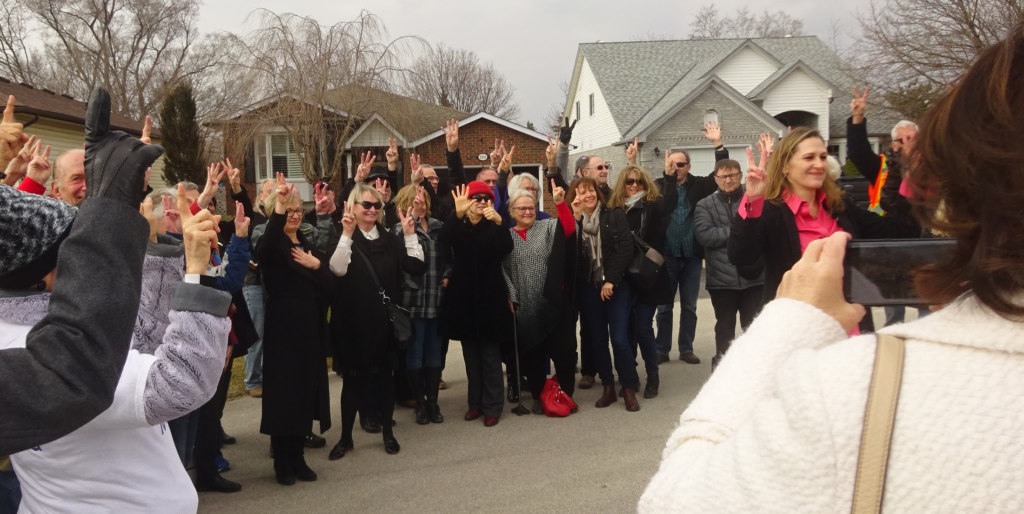 Meed Ward supporters indicating which ward they lived in – representatives from every ward were there. Her campaign was about sensible, responsible development. She spoke to a small, enthusiastic audience at the top of Clearview Avenue overlooking the site on which the ADI Development Group is building what will amount to a new neighbourhood that will align with the mobility hub, the plans for which have yet to be finalized.
An application has been made to change the Official Plan designation to High Density Residential to allow the development of a mid-rise, 6-storey apartment building, with 160 dwelling units at a density of 258 units per hectare. A rezoning application has also been made to change the corresponding zoning to a site specific Residential High Density RH1.
 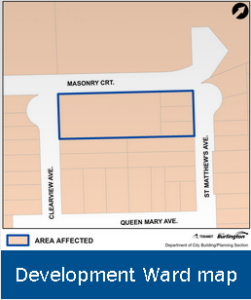 The lands are currently designated as low density residential in the City’s Official Plan which allows for detached and semi-detached dwellings, and other forms of ground oriented housing not exceeding 25 units per hectare. The lands are zoned R2.1 in the City’s Zoning By-law which allows for detached dwellings and an accessory dwelling unit within a detached dwelling. The lands are currently designated as low density residential in the City’s Official Plan which allows for detached and semi-detached dwellings, and other forms of ground oriented housing not exceeding 25 units per hectare. The lands are zoned R2.1 in the City’s Zoning By-law which allows for detached dwellings and an accessory dwelling unit within a detached dwelling.
A date for the first public meeting has not yet been set.

 By Jim Young By Jim Young
February 18th, 2019
BURLINGTON, ON
In recent Gazette articles and comments, Burlington’s 25 Year Strategic Plan, “Grow Bold”, has garnered much criticism of its name and the plausibility of a vague plan that looks 25 years ahead.
 Grow Bold got the boot – the Mayor had to almost push it out the door. The name really doesn’t matter. Call it Grow Bold, Grow Smart or just The 25 Year Plan; having a plan is important. To achieve anything of consequence we need a longer term view of how our city might look in 25 years. That view is necessarily vague and aspirational; who really knows where we will be by then?
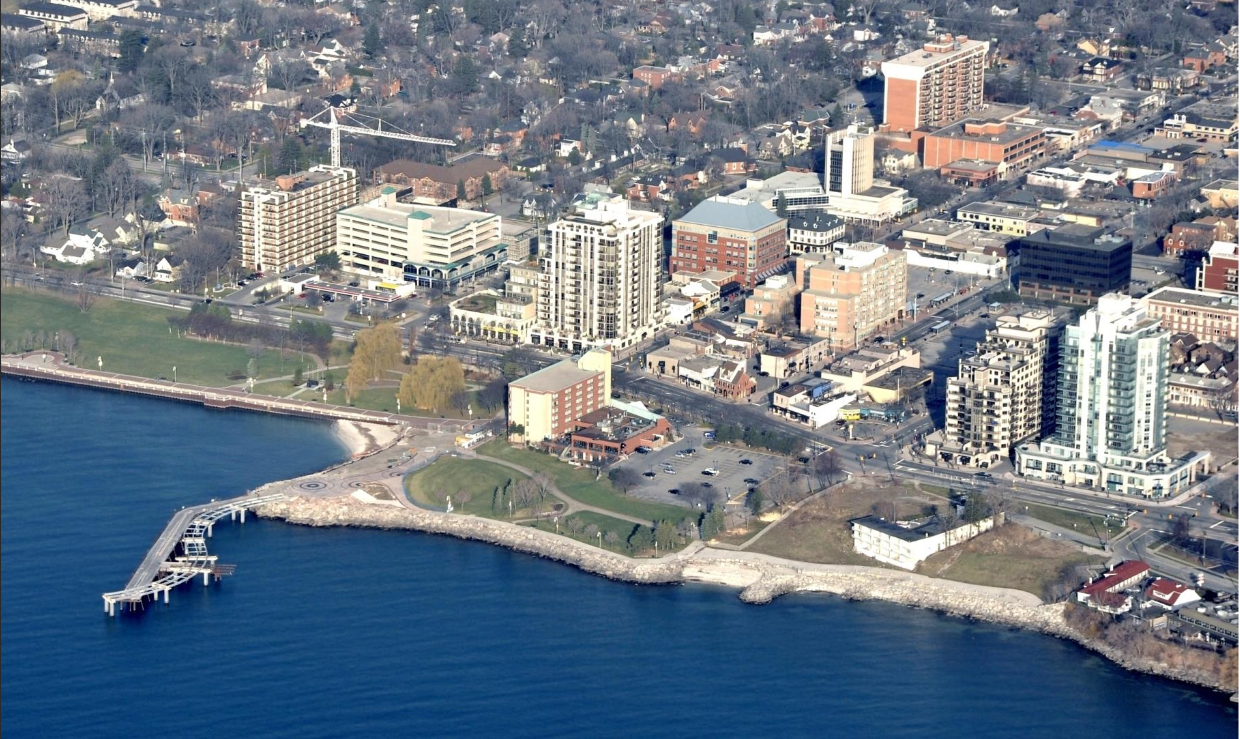 This aerial of the city is going to look a lot different in five years – in a decade you won’t recognize the place, A personal analogy might be a 40 year old planning to retire at 65. How will that retirement look in 25 years? Do I want to travel? Spend time with grandkids? How will I pay my rent? Will I have to keep working? Of course these possibilities may change over the 25 years, but we still need to plan for them. You cannot drive to Florida if your GPS is only programmed to the end of the street. Unless we are extremely lucky, little in life is achieved without a plan. Call this our “Retirement Strategic Plan.”
 The creation of the 2010 -2014 Strategic Plan was a city staff – city council effort that then went to the public. They filled pages of flip chart work but found at the end of the sessions that city staff and council were on different sides of a fence. It was that way for the term and the one that followed. Then we need more specific details: How much should we save and where will that money come from. Will it be RRSPs? Tax Free Savings? Is there a Company Pension? Can I live in my kid’s basement if my Retirement Strategic Plan doesn’t work? This is the meat & potatoes of our planning. Call it our Retirement Official Plan.
Then come the bumps on the road to retirement. When we run into car repairs or the basement floods, when we face short time work or job loss: Changes we must make to our plans. “Amendments to The Retirement Official Plan.” Doubtless we will have contentious domestic debate about these.
Municipalities need plans too. City planners work on at least three levels, with many sub levels in between. The Strategic Plan, The Official Plan and Zoning / Bylaw Amendments to those plans.
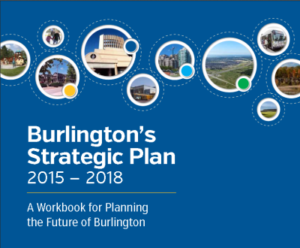 It started out as a four year plan – the term of a city council …. The Strategic Plan: A long term, aspirational view of where we might like to be in 25 years. Obviously no-one really knows where we will be by then; but we must have an idea of how we want our city to evolve over that period. This is the one plan that Burlington consulted citizens on and actually did a reasonable job on.
 … and just sort of grew when a consuklting firm with the compliance of the then city manager took council in a much different direction. The Official Plan; a detailed and much more pertinent document, sets out the steps needed to realize the strategic vision. Mandated by the province for regular review, it re-evaluates the plan to adjust for economic, social, demographic and political shifts that may not be foreseeable but will inevitably take place over 25 years.
This is the plan that should have defined the transit, parking, congestion, intensification plans and area/zone specific heights as they evolved over the next 5 years of that 25 year strategy. Sadly our last City Council failed to provide an Official Plan that met regional requirements and utterly misjudged local sentiment on every level.
Outraged citizens vented their anger in wholesale changes at the last election.
Lastly there are Amendments to the Official Plan and the Zoning Bylaws of that plan. These are often the most contentious and time consuming aspects of city planning. Amendments address those changes to residential, commercial and retail building in our neighbourhoods, which have greatest impact on life and work in our communities.
No matter what the Strategic or Official Plans say about height and density on your street or the plaza at the end of the block, developers can apply to amend the plan or zoning bylaw. These are the matters that are currently the most contentious in our city.
Subject to a 210 day deadline for response by municipalities, there are so many zoning / bylaw amendments active in Burlington that city planners are failing to respond to them in time, opening the door to so many appeals by developers.
These are not failures of the strategic plan. They are failures of process, of consultation and, of course, they must be addressed. In its early actions Council has demonstrated a willingness to address these issues and already there is a feeling that city staff are adapting to this new council paradigm.
We can and should oppose bad planning, we deserve greater say in the plans and the processes, but instead of abandoning the discipline of Strategic Planning, let us work with our new council and city planners to make these plans better. Let us align city plans with citizen visions rather than developer bottom lines in the knowledge that the only thing worse than a Vague Long Term Plan is No Long Term Plan At All.
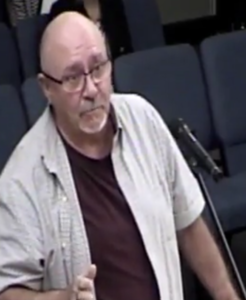 Jim Young delegating at city hall. Jim Young is an Aldershot resident who delegates at city Council frequently and has, in a number of cases, given some very wise advice. It was seldom received with much in the way of grace by the 2010 to 2018 city council

|
|
 By Jim Feilders
By Jim Feilders 1 to 5 storeys over the limit, XXX per floor
1 to 5 storeys over the limit, XXX per floor 1-19 km/h over the speed limit is a $2.50/km speeding fine.
1-19 km/h over the speed limit is a $2.50/km speeding fine. 30 to 50 cm, $1400 per tree removed
30 to 50 cm, $1400 per tree removed Jim Feilders is an engineer by training and an environmentalist by choice. He drives a hybrid car, heat and air conditions his house at a cost of of approximately $375 a year. The views expressed here are solely his own and not necessarily those of the various organizations with which he is associated.
Jim Feilders is an engineer by training and an environmentalist by choice. He drives a hybrid car, heat and air conditions his house at a cost of of approximately $375 a year. The views expressed here are solely his own and not necessarily those of the various organizations with which he is associated.














 Many have used their being named one of the Best as a launch for a political career. There have been some abuses: wives have nominated husbands; mothers have nominated sons
Many have used their being named one of the Best as a launch for a political career. There have been some abuses: wives have nominated husbands; mothers have nominated sons







 Ray Rivers writes weekly on both federal and provincial politics, applying his more than 25 years as a federal bureaucrat to his thinking. Rivers was a candidate for provincial office in Burlington where he ran against Cam Jackson in 1995, the year Mike Harris and the Common Sense Revolution swept the province. He developed the current policy process for the Ontario Liberal Party.
Ray Rivers writes weekly on both federal and provincial politics, applying his more than 25 years as a federal bureaucrat to his thinking. Rivers was a candidate for provincial office in Burlington where he ran against Cam Jackson in 1995, the year Mike Harris and the Common Sense Revolution swept the province. He developed the current policy process for the Ontario Liberal Party.
 This new proposal from Carriage Gate (the developer behind the 421 Brant St development which led to the creation of ECoB) suggests a level of massing, setbacks and overall height that massively exceeds both the in force Official Plan and the ‘Grow Bold’ Official Plan introduced by the last council. Regardless of one’s opinions at the 2018 municipal election, this development completely disregards all attempts by Council to moderate development downtown.
This new proposal from Carriage Gate (the developer behind the 421 Brant St development which led to the creation of ECoB) suggests a level of massing, setbacks and overall height that massively exceeds both the in force Official Plan and the ‘Grow Bold’ Official Plan introduced by the last council. Regardless of one’s opinions at the 2018 municipal election, this development completely disregards all attempts by Council to moderate development downtown.

 Following a complaint of aggressive driving made to the Halton Regional Police “Road Watch” program, Regional Police Officers were tasked with an early morning patrol to try and catch an unknown driver.
Following a complaint of aggressive driving made to the Halton Regional Police “Road Watch” program, Regional Police Officers were tasked with an early morning patrol to try and catch an unknown driver.
 Conservation Halton advises that areas of the watershed are forecast to receive 5 to 10 mm of rain beginning Saturday evening.
Conservation Halton advises that areas of the watershed are forecast to receive 5 to 10 mm of rain beginning Saturday evening.

 The people at the Art Gallery are so certain that we will they have announced “ officially “ that Spring + Summer Program Registration opens Wednesday, March 13!
The people at the Art Gallery are so certain that we will they have announced “ officially “ that Spring + Summer Program Registration opens Wednesday, March 13!





 The Spring/Summer Live and Play guide, featuring listings for city recreation, sport and culture programs is available online on the City of Burlington website. Printed copies of the guide are available at City Recreation Facilities, City Hall and the Burlington Public Libraries.
The Spring/Summer Live and Play guide, featuring listings for city recreation, sport and culture programs is available online on the City of Burlington website. Printed copies of the guide are available at City Recreation Facilities, City Hall and the Burlington Public Libraries.
 “Parks and Rec tried to make seniors bring their own equipment for Pilates (like large Pilate balls and bands) starting in the Spring and only when this came to light and reported on did Parks & Rec back down.
“Parks and Rec tried to make seniors bring their own equipment for Pilates (like large Pilate balls and bands) starting in the Spring and only when this came to light and reported on did Parks & Rec back down.
 During the Capital Budget Standing Committee meeting today Tim Commisso was addressed as the Interim City Manager. A couple of chuckles were heard from the Staff Section of the council seating.
During the Capital Budget Standing Committee meeting today Tim Commisso was addressed as the Interim City Manager. A couple of chuckles were heard from the Staff Section of the council seating. The financial requirement for Information Technology was in the millions and brought to light some serious issues that were not known or discussed at anything length at previous budget meetings.
The financial requirement for Information Technology was in the millions and brought to light some serious issues that were not known or discussed at anything length at previous budget meetings.


 Alykhan Velshi, Brown’s chief of staff is a brilliant 30-something lawyer and policy analyst with credentials from the London School of Economics. He spent his formative years developing his skills as a neoconservative, first at the American Enterprise Institute and the Foundation for the Defence of Democracies, then as a political operative in the government of former PM Stephen Harper.
Alykhan Velshi, Brown’s chief of staff is a brilliant 30-something lawyer and policy analyst with credentials from the London School of Economics. He spent his formative years developing his skills as a neoconservative, first at the American Enterprise Institute and the Foundation for the Defence of Democracies, then as a political operative in the government of former PM Stephen Harper. In fact almost all of caucus officially supported Brown’s ‘People’s Guarantee” which was endorsed at the party’s November 2017 policy conference. Though Velshi’s previous mentor, Albertan Jason Kenny, stormed out of the conference once he realized that a carbon tax was one of those policies.
In fact almost all of caucus officially supported Brown’s ‘People’s Guarantee” which was endorsed at the party’s November 2017 policy conference. Though Velshi’s previous mentor, Albertan Jason Kenny, stormed out of the conference once he realized that a carbon tax was one of those policies.











 The lands are currently designated as low density residential in the City’s Official Plan which allows for detached and semi-detached dwellings, and other forms of ground oriented housing not exceeding 25 units per hectare. The lands are zoned R2.1 in the City’s Zoning By-law which allows for detached dwellings and an accessory dwelling unit within a detached dwelling.
The lands are currently designated as low density residential in the City’s Official Plan which allows for detached and semi-detached dwellings, and other forms of ground oriented housing not exceeding 25 units per hectare. The lands are zoned R2.1 in the City’s Zoning By-law which allows for detached dwellings and an accessory dwelling unit within a detached dwelling.










